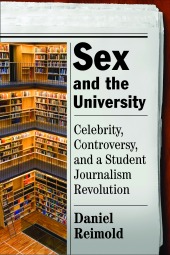Thanksgiving stinks for vegans. The holiday has lost its national significance, serving mostly as a prelude to Black Friday fervor. The festivities involve family interactions that often result in a six-word stage play of sorts: “Eat pray love drink fight slap.” And the best part of the holiday, its accompanying break from school, needs to be longer.
—
These are just a few of the Thanksgiving-themed perspectives college students have shared in recent days within their campus newspapers and magazines.
—
Rachel Arlin at the University of Massachusetts Amherst asks the big-picture question, seemingly on behalf of many students: “Does Thanksgiving matter anymore?”
—
As she writes in The Massachusetts Daily Collegian, “It is a known fact that America has turned into a materialistic country. . . . Black Friday is a significant factor in this materialistic movement. People are frantically worried about Christmas while Thanksgiving is pushed to the side, or in some cases, even ignored. . . . I was looking up ‘Thanksgiving’ under Yahoo’s search box and the first result that came up was ‘Walmart Thanksgiving Sale 2012.’ I don’t know about you, but this sickens me.”
—
—
State Press columnist Jonathan Fortner at Arizona State University agrees, noting, “Sandwiched between Halloween and Christmas– the two most greedy and selfish of our nation’s pastimes– Thanksgiving is but a few days away. In the upcoming days, shopping stores will open their doors as the sun peaks above the horizon. Hordes of consumers will stampede their way up and down shopping aisles, fulfilling the wants of their loved ones and even some of their own. . . . Over time, Thanksgiving has been reduced to a mere gluttonous affair where we stuff more than turkey. There’s more to this shortened work and school week than gorging on pumpkin pie and cranberry sauce– at least there should be.”
—
—
Meanwhile, DePauw University sophomore Ryan Konicek specifically takes issue with the shortness of the Thanksgiving school break. As she writes in The DePauw, “[W]e are allotted a total of five days for our Thanksgiving holiday– three school days and a weekend. I do not believe that the amount of time given to us is enough. . . . I believe having a week off of classes to honor the Thanksgiving holiday is fair, especially for those that have to travel.”
—
Konicek’s strongest point in her push for a longer holiday respite: Many students, faculty, and staff are already checking out during the shortened pre-Thanksgiving week anyway.
—
“The Monday and Tuesday before Thanksgiving break are usually days where not much is covered in class because the teachers are just as antsy as the students to leave,” she writes. “Papers may be due and then discussed, attempts at having an engaging lesson may be tried, but both the students and teachers know that it is useless. People’s minds are not focused on what is being taught in the classroom, instead their thoughts are about the holiday ahead and all the other people who are already out of school and on vacation.”
—
—
Yet, as Daily Trojan columnist Nick Cimarusti at the University of Southern California contends, the vacation itself is not entirely stress-free– often becoming “a cause of worry for many college students reluctant to discuss their college experiences.”
—
As he writes, “The communal aspect of the Thanksgiving meal invites us to share with others ideas and thoughts along with stuffing and cranberry sauce. For this reason, going home for Thanksgiving break invites the dreaded question: ‘So what have you been up to all semester?’”
—
To this end, Rocky Mountain Collegian reporter Bailey Constas at Colorado State University presents the following advice as part of a larger “Thanksgiving Survival Guide”: “Come up with three topics that you’ve learned in class to convince your parents you’re not just spending all their money on beer. It could be a new word you picked up when you didn’t understand that prompt on your midterm, that concept in philosophy that will go over your parents’ heads or a topic in sociology that you know your dad will disagree with.”
—
—
Speaking of sheer survival, Rochester Institute of Technology student Nicole Howley provides the vegan perspective on Thanksgiving. As she writes for RIT’s Reporter Magazine, “I like the whole ‘giving thanks’ thing, but Thanksgiving seems to have become more about stuffing your face with dead things, animal products, and pie than being thankful. And if you don’t want any of those foods, then what’s even the point? Eating a few plain, steamed green beans and some pasta with mushroom gravy isn’t really a good celebration either.”
—
—
Happy Thanksgiving!
—
—






























































